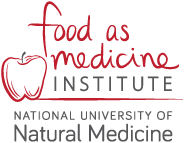We Love Broccoli here at the Food as Medicine Institute, so we’re celebrating this day with a post by first-year Master of Science in Nutrition student Laura Jarrell in which she shares how to Boost your broccoli!
Boost your broccoli!
by Laura Jarrell, NUNM Master of Science in Nutrition student
Broccoli, a brassica vegetable, is a rich source of compounds called glucosinolates, including glucoraphanin. Myrosinase, an enzyme present in broccoli, activates glucoraphanin to an isothiocyanate called sulforaphane. Sulforaphane supports the human body in a number of health-promoting ways. It’s an antioxidant, promotes detoxification (by inhibiting phase I and inducing phase II), has anti-cancer properties, is anti-apoptotic, improves bone health, and supports general gut and cardiovascular health. Sulforaphane’s anti-inflammatory effects in the brain have been shown to improve verbal communication and social interaction markers in those with autism (1), and to treat neurodegenerative diseases such as Alzheimer’s disease, Parkinson’s disease, and multiple sclerosis (2). These significant benefits are great news for Americans, who on the whole really love broccoli!
Back to myrosinase though, since that’s needed to make these properties bioavailable. The enzyme is released from broccoli plant tissues to perform its alchemy when those tissues are disturbed in some way – being sliced, bitten, chewed, or broken all qualify. However, heat destroys myrosinase and significantly reduces the quantity of glucosinolates available, so those who consume cooked broccoli may not be absorbing as much sulforaphane as they might if it were uncooked (1). Although one could say any broccoli is better than no broccoli, consuming raw broccoli leads to faster absorption, higher bioavailability, and higher absorption of sulforaphane compared to cooked broccoli (3).
Although broccoli is an undeniably popular vegetable, I bet it’s more commonly consumed in a cooked form (blanched, microwaved, steamed, roasted, etc.) as opposed to raw. The rough texture and bitterness of broccoli (as well as other brassica vegetables) don’t necessarily make it an easy vegetable to consume uncooked, and even learning about the potential health benefits of raw vs. cooked is not likely to change that. However, I learned in a Healing Foods class lecture about slicing broccoli and letting it sit on the cutting board for a few minutes to let the myrosinase do some of its enzymatic work, and found that this is a really simple way to potentially improve the bioavailability of sulforaphane in cooked broccoli.
So, in an effort to maximize the benefits from my broccoli consumption, I looked for a way to consume raw broccoli. I found that broccoli salad is a delicious and popular way to eat raw broccoli! Try this recipe at home for a tasty version of a deli counter favorite.
References:
1. Vanduchova A, Anzenbacher P, Anzenbacherova E. Isothiocyanate from Broccoli, Sulforaphane, and Its Properties. J Med Food. 2019;22(2):121-126. doi:10.1089/jmf.2018.0024. Accessed January 18, 2023.
2. Schepici G, Bramanti P, Mazzon E. Efficacy of Sulforaphane in Neurodegenerative Diseases. International Journal of Molecular Sciences. 2020; 21(22):8637. https://doi.org/10.3390/ijms21228637. Accessed January 18, 2023.
3. Vermeulen M, Klöpping-Ketelaars IW, van den Berg R, Vaes WH. Bioavailability and kinetics of sulforaphane in humans after consumption of cooked versus raw broccoli. J Agric Food Chem. 2008;56(22):10505-10509. doi:10.1021/jf801989e. Accessed January 18, 2023.
Raw Broccoli Salad
(Adapted from NY Times Cooking)
Yield: 4-6 servings
Ingredients:
For the Dressing:
· ½ cup golden or black raisins (or dried cranberries)
· ½ red onion, finely sliced
· ¼ cup apple cider vinegar
· 4 teaspoons granulated sugar
· Kosher salt
· 3 tablespoons extra-virgin olive oil
· 1 tablespoon sesame oil
For the Salad:
· 1½ pounds broccoli (about 2 heads)
· 1 apple (any variety), cored and cut into ½-inch cubes
· 2 scallions, white and green parts, finely sliced
· Kosher salt (such as Diamond Crystal) and black pepper
· ½ cup toasted sliced almonds, pepitas or sunflower seeds
· 1 cup red or green grapes (optional), halved crosswise
Instructions:
1. Make the dressing: Place raisins and red onion in a small bowl. Add vinegar, sugar, ¾ teaspoon salt and 2 tablespoons of water, and toss to combine. Leave to pickle for 10 minutes while you prepare the rest of the ingredients.
2. Peel the woody exterior from the broccoli stalks and discard. Chop the stalks into ½-inch pieces. Chop the broccoli florets into ½-inch pieces. (Myrosinase, do your thing!) Place all the broccoli pieces into a large mixing bowl.
3. After 10 minutes, finish the dressing by adding the olive oil and sesame oil to the bowl with the pickling raisins and red onion, and stir well to combine. Taste and season with more salt if needed. It should be tangy, slightly sweet and a little salty.
4. Add the raisin-and-onion dressing to the broccoli along with the apple and scallions. Using two large spoons, toss so that everything is well coated. Season with ½ teaspoon salt and black pepper to taste.
5. When you are ready to eat, add the almonds and grapes (if using), and gently toss. Serve at room temperature.

